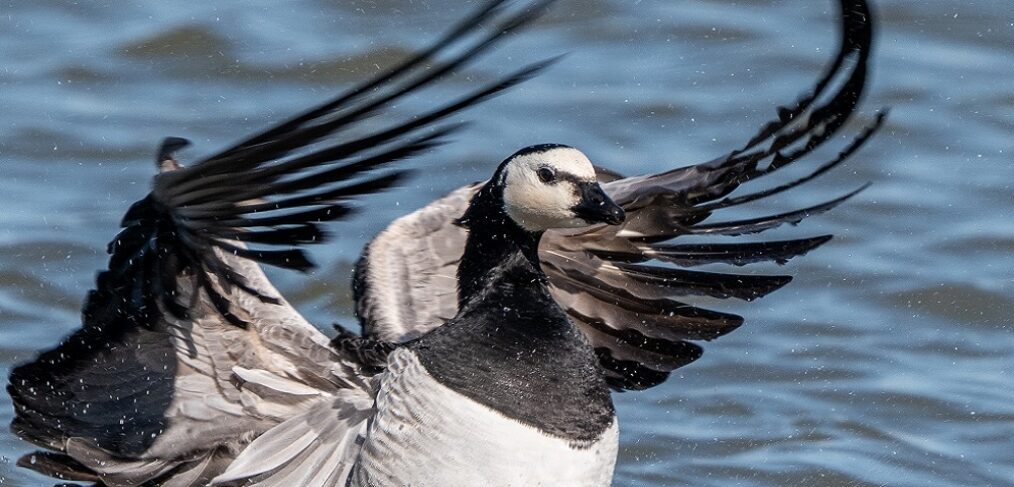
Species of the week #82 -Barnacle goose
A loudly chattering flock of geese flies overhead? Then it’s worth taking a closer look. Sometimes you can spot individual geese of a different colour among them. These are most likely barnacle geese. They like to take advantage of the protection of a large flock of geese and therefore fly with greylag geese or Canada geese, which are now also common here, from their Arctic homeland to spend the winter in Germany. They can still sometimes be seen along the Rhine.
| Distribution status in Rhineland-Palatinate | extremely rare |
| Residual occurrence | Along the Rhine |
| Last sighting in Rhineland-Palatinate | currently |
| Habitat | Seashores, floodplains |
| Threat | Hunting, habitat loss |
The barnacle goose lives in the Arctic tundra in summer. It likes to spend the winter in Germany, Denmark or the Netherlands. It is not endangered, but rarely found in Rhineland-Palatinate. Its total population in the north-eastern region is estimated at 1.3 million. In the last ten years it has been sighted 25 times in Rhineland-Palatinate, regularly mainly in Bobenheim-Roxheim.
Barnacle Geese travel in pairs in the Arctic tundra during the breeding season and then breed in small colonies, often near nests of birds of prey. They like to build their nest on cliffs and rock faces and can usually only reach it by flying.
They eat what little there is in the Arctic: Lichens, mosses, grasses, young shoots, roots and buds. On the fertilised meadows along the Rhine, they regularly get quite fat, because otherwise they don’t get such nutrient-rich food. So well-fed, however, they at least manage the long way back.
The barnacle goose is medium-sized, with a short neck and a small, curved beak. The neck and head are black, the face is white over a large area. The silvery-white breast contrasts sharply with the black neck. The back is elegantly banded in light and dark grey. In flight, the upper surfaces of the wings appear blue-grey. The colouring of the Barnacle Goose is thus somewhat reminiscent of a black and white habit, hence it is named.
Since a complete hunting ban was imposed in the 1970s, the population of the white-cheeked goose has recovered. At that time, there were only 50,000 birds in the whole of northern Europe, including Russia. Today, the population in the entire range is probably back at the level of the 19th century.
Due to increasing industrialisation in the Baltic States, the barnacle goose has lost its wintering grounds on the coasts and wetlands. Therefore, they stay longer and longer in the Wadden Sea, which they used to use only as a stopover. As expected, this leads to conflicts with agriculture. There are various approaches to solving these. In Schleswig-Holstein, the nature conservation associations propose toleration and displacement areas. In tolerated areas, farmers receive compensation if they do not drive the geese from their meadows. In Lower Saxony, farmers receive compensation if they make land in Natura 2000 areas goose-friendly, regardless of whether a goose passes by or not. In the Netherlands, farmers are compensated for crop losses. In Denmark, on the other hand, exemptions can even be granted for hunting geese. According to Danish researchers, this is an inappropriate way to prevent damage.
Click here for more exciting species of the week
Picture: By Michael Graf – Own work, CC BY-SA 4.0, https://commons.wikimedia.org/w/index.php?curid=106143291
